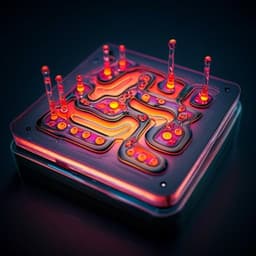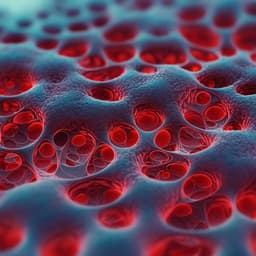
Physics
Flexible entanglement-distribution network with an AlGaAs chip for secure communications
F. Appas, F. Baboux, et al.
This innovative research showcases a scalable entanglement distribution network using a telecom-wavelength broadband entangled photon source, successfully achieving flexible entanglement distribution among up to 8 users. Conducted by Félicien Appas, Florent Baboux, Maria I. Amanti, Aristide Lemaître, Fabien Boitier, Eleni Diamanti, and Sara Ducci, this work promises enhanced quantum network architectures with high secret key generation rates and low error across diverse fiber links.
~3 min • Beginner • English
Introduction
The study addresses how to build scalable, flexible, and cost-efficient quantum communication networks capable of supporting advanced applications such as secure communication, delegated/blind quantum computing, and distributed quantum computing and sensing. A key challenge is distributing high-quality entanglement among multiple users in a way that scales, particularly given that frequency-channel requirements can grow quadratically with the number of users and cascaded passive components introduce loss. The authors propose leveraging a broadband AlGaAs entangled photon source at telecom wavelengths together with reconfigurable wavelength selective switch (WSS) technology (Flexgrid) to realize a fully connected, multi-user entanglement distribution network. They aim to maintain high entanglement fidelity across a wide spectral range and distances, and validate performance via the BBM92 quantum key distribution protocol, including both asymptotic and finite-size regimes, under symmetric and asymmetric link configurations. The work also explores flexible bandwidth allocation to balance link performance in unbalanced network scenarios.
Literature Review
Methodology
System architecture and components: The setup comprises three stages: (1) entanglement generation on an AlGaAs Bragg reflection ridge waveguide via type-II SPDC pumped by a tunable CW 780 nm diode laser; (2) frequency demultiplexing/multiplexing using either a wavelength selective switch (WSS) in the C-band (1530–1565 nm) or a coarse WDM (CWDM, 13 nm channels) plus tunable filter in the L-band (1565–1625 nm); and (3) distribution to users with polarization analysis and detection by superconducting nanowire single-photon detectors (SNSPDs). The chip operates near room temperature with active temperature control (19.3 °C), setting degeneracy at 1556.55 nm (ITU 100 GHz channel 26). The pair production rate is ~10^4 pairs/s at the chip output, corresponding to brightness of 3.6×10^5 pairs/s/mW. The heralding efficiency is 9.4%.
Source properties and bandwidth: Due to small birefringence and suitable dispersion/nonlinear properties, the AlGaAs chip emits time-energy and polarization-entangled photons in the |ψ+⟩ Bell state without off-chip walk-off compensation. The biphoton bandwidth was measured by inserting a C+L tunable filter after a 50/50 fiber BS and registering coincidences with SNSPDs and TDC, yielding a FWHM of 60 nm (~72 ITU 100 GHz channels, 36 on each side of degeneracy).
Entanglement characterization: For symmetric channel pairs about degeneracy, the lower bound to the fidelity to |ψ+⟩ is estimated by projecting onto two mutually unbiased bases, Z={|H⟩,|V⟩} and X={|D⟩,|A⟩}, and recording coincidence counts in eight configurations: C_HH, C_HV, C_VH, C_VV, C_DD, C_DA, C_AD, C_AA. From these, diagonal density matrix elements are obtained and a lower bound to fidelity is computed using F ≥ (P_HV + P_VH − P_HH − P_VV + P_DD + P_AA − P_DA − P_AD) − 1. Experiments near degeneracy used the WSS to define channels; far from degeneracy (L-band) used CWDM plus tunable filter. A theoretical SPDC model incorporating dispersion, phase matching, and, when needed, cavity effects from facet reflectivity via a two-mode Airy distribution was used to simulate fidelity versus detuning, matching experimental data.
QKD protocol and metrics: The BBM92 protocol is implemented as a proof-of-principle by deterministically routing signal (higher-frequency) and idler (lower-frequency) photons via the WSS to separate paths with polarization analysis (HWPs/QWPs and FPBS) and SNSPDs. Manual basis selection is used to acquire the same 8 measurement configurations as above. For 13 different ITU 100 GHz channel pairs within the WSS C-band, raw coincidences in X and Z are C_X^(raw)=C_HH+C_HV+C_VH+C_VV and C_Z^(raw)=C_DD+C_DA+C_AD+C_AA; QBER ε=(C_HH+C_VV+C_DA+C_AD)/(C_X^(raw)+C_Z^(raw)); raw key rate R_raw=(1/2)((C_X^(raw)/T)+(C_Z^(raw)/T)); asymptotic key rate R_key≥R_raw(1−f(ε)H2(ε)−H2(ε)) with binary entropy H2 and error-correction efficiency f(ε) from tabulated interpolation (bidirectional code). The 1/2 accounts for basis sifting.
Long-distance testing: To assess distance performance, 25 km SMF28 spools are added between demux/mux and user stations for symmetric (25+25 km) and asymmetric (0+25 km) links. Polarization is manually compensated per link length. Representative channels 23 (1558.98 nm) and 29 (1554.13 nm) are used. Additional tests replace fiber with programmable attenuation on the WSS, mapping attenuation to equivalent distance using 0.22 dB/km. Theoretical curves for fidelity, QBER, and asymptotic key rates follow models for BBM92 with passive basis selection. Finite-key analysis follows a composable security framework with correctness and security parameters 10^−10 and 10 min block size to derive finite-size secret key rates.
Multi-user networks and bandwidth flexibility: A central server hosts the source and WSS; N user nodes receive reconfigured frequency channels such that every user shares entanglement with all others (complete graph with N(N−1)/2 links, supported by N(N−1)/2 conjugate channel pairs). The WSS demultiplexes and multiplexes channels to user fibers. By adjusting channel widths, the network is reconfigurable from N=4 (200 GHz) to N=8 (50 GHz) within the WSS C-band overlap. Time-correlation histograms for all two-user links are acquired sequentially for N=4,5,8; relative standard deviations of peak counts quantify uniformity. Channel bandwidth dependence of fidelity, QBER, and asymptotic key rate is measured for channels 23/29, showing bandwidth insensitivity of fidelity and QBER and linear scaling of key rate with bandwidth. To demonstrate elastic networking, an unbalanced N=5 network is created with one user 25 km away; a simple bandwidth reallocation algorithm (12.5 GHz granularity) increases channel widths for longer links and reduces for shorter ones, equalizing coincidence rates across all 10 links.
Key Findings
- The AlGaAs chip generates broadband polarization-entangled photon pairs with a biphoton FWHM bandwidth of 60 nm (~72 ITU 100 GHz channels).
- Measured lower bound on Bell-state fidelity exceeds 95% over a 26 nm spectral range (first 13 conjugate 100 GHz channel pairs) and remains above 85% across a 60 nm span; experimental data agree with theory including cavity effects far from degeneracy.
- At 0 km (post demux), across 13 ITU 100 GHz channel pairs (10.4 nm span), QBER remains below 2% (well under the 11% threshold), with asymptotic key rates between 28 and 39 bits/s, stable across channels.
- Long-distance tests using channels 23 and 29 show high-quality entanglement and BBM92 performance in both symmetric (25+25 km) and asymmetric (0+25 km) configurations. Finite-size secure key rates (10 min blocks, correctness and security 10^−10) remain positive up to ~75 km in both cases. Asymptotic positive key rates extrapolate up to ~250 km (symmetric) and ~215 km (asymmetric), limited by increasing QBER as signal approaches noise in the asymmetric case.
- Multi-user fully connected networks: N=4 (200 GHz channels), N=5 (100 GHz), and N=8 (50 GHz) configurations are demonstrated sequentially. Coincidence counts are uniform across links with relative standard deviations of ~7% (N=4), ~9% (N=5), and ~11% (N=8), reflecting source flatness and WSS wavelength-independent losses.
- Channel bandwidth dependence: Fidelity is essentially insensitive to bandwidth; QBER shows weak dependence; asymptotic key rate scales approximately linearly with channel width, supporting performance across 50–200 GHz channels.
- Flexible bandwidth allocation in an unbalanced N=5 network (one user at 25 km) equalizes per-link coincidence rates by reallocating spectral bandwidth (12.5 GHz granularity), demonstrating elastic resource optimization.
- Additional metrics: Raw two-photon interference visibilities of ~98.0% (Z) and ~97.7% (X) measured for channels 23/29; CAR on peak configurations ~4×10^−3; heralding efficiency 9.4%.
Discussion
The results directly address the challenge of scalable, flexible entanglement distribution in quantum networks by combining a broadband, robust AlGaAs entangled photon source with an industry-standard WSS Flexgrid. High and uniform entanglement fidelity across a 60 nm span enables many conjugate channel pairs, supporting the quadratic channel scaling of fully connected networks. WSS-based reconfigurability allows dynamic assignment of center frequencies and bandwidths, overcoming the loss and rigidity of cascaded passive WDM approaches. Benchmarking with BBM92 shows low QBER and respectable key rates at zero distance and robustness over metropolitan-scale links, with positive finite-size secure rates up to 75 km in both symmetric and asymmetric configurations. The similar finite-key performance for both link types indicates the practicality of architectures where one user is distant and others are local, without undue penalties. Demonstrations of N up to 8 users and bandwidth reallocation to equalize link performance highlight the viability of elastic, software-defined quantum networking aligned with classical telecom practices. Collectively, these findings show that AlGaAs chip sources, paired with WSS technology, can underpin reconfigurable, scalable, and efficient entanglement distribution for multi-user quantum communication.
Conclusion
The work demonstrates a reconfigurable, fully connected entanglement distribution network using an AlGaAs chip source emitting broadband polarization-entangled photon pairs in the telecom band. Entanglement fidelity remains above 95% over 26 nm and above 85% over 60 nm. Using a WSS, the photons are deterministically separated into conjugate frequency channels and distributed to users. BBM92 QKD tests yield QBER below 2% and asymptotic key rates of 28–39 bits/s across many channels, with finite-size secure keys over distances up to 75 km for both symmetric and asymmetric links, and asymptotic positive key rates predicted up to 250 km (symmetric) and 215 km (asymmetric). Multi-user operation is shown for N=4, 5, and 8 users by tuning channel bandwidths, with uniform link performance and bandwidth-insensitive fidelity. A bandwidth reallocation strategy equalizes link rates in an unbalanced network, supporting elastic operation. Future work includes anti-reflection coatings and reduced modal birefringence to mitigate cavity effects and broaden bandwidth, centering degeneracy within the C-band, extending WSS coverage to C+L to exploit full source bandwidth, optimizing waveguide length for brightness and bandwidth, performing real-world metropolitan deployments, exploring alternative topologies (e.g., interconnected 4-user subnets scaling to ~28 users over 50 GHz channels without extra passive losses), and leveraging cavity effects for frequency-comb-based quantum information combining polarization and frequency entanglement.
Limitations
Observed fidelity degradation at large detunings is attributed to cavity effects from facet reflectivity and residual birefringence; anti-reflection coatings and design optimization are needed to mitigate this. The WSS used limits operations to the C-band; L-band demonstrations required CWDM plus tunable filters and provided fewer data points. Degeneracy is not centered in the C-band, limiting exploitation of the WSS range; redesign could address this. Finite-size secure key rates were demonstrated with 10 min blocks; longer blocks or parallel detection could improve rates. The experiments relied on manual polarization compensation; deployed systems would require active polarization control. Multi-user QKD sessions were characterized sequentially due to limited detector resources, not all users in parallel. Timing equalization across channels may be necessary in real-time multi-channel detection to avoid increased QBER from wider coincidence windows.
Related Publications
Explore these studies to deepen your understanding of the subject.







